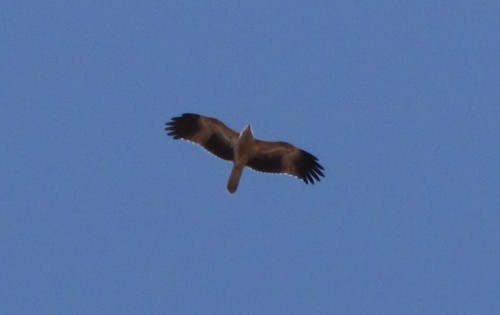Whistling Kite overhead at Pangarinda
Last week I wrote about the Tree Martins I saw and photographed at the Pangarinda Botanic Gardens near Wellington in South Australia. We were having an afternoon relaxing in the gardens to celebrate my wife’s birthday. You can read about the Tree Martins here.
While we were having a cuppa and some birthday cake with our friends I was taking note of all the birds I saw and heard. It was a lovely sunny day with a cooling breeze making the afternoon very pleasant indeed.
During the afternoon we saw and heard many birds, including plenty of New Holland Honeyeaters, both Red and Little Wattlebirds, Rainbow Bee-eaters, White-browed Babblers and even several Brown Quail. Go to the reading list at the end of this post for a link to the article about the quail.
While we were sitting at the picnic table having our afternoon cuppa a Whistling Kite soared overhead a number of times. I managed to get one reasonable photo, the one shown above. I still have yet to master the art of taking photos of birds in flight. The other shots are either too blurry, or too far away to be useful.
Whistling Kites are quite common along the Murray River in South Australia. The botanic gardens at Wellington are barely 500 metres from the river and possibly even closer to some of the reed-covered banks nearby, so I was not surprised to see one overhead. In fact, this species is common throughout most of mainland Australia where suitable habitat exists. Their preferred habitat includes open woodlands usually near water, along creeks, rivers, lakes and swamps where there are suitable nesting and roosting trees. They occasionally can be seen in Tasmania too.
Further reading:
- Tree Martins all a twitter
- Calling up a Brown Quail
- Birds and plants of the Pangarinda Arboretum (this was the early name for these gardens).
Butterfly at Pangarinda Arboretum, Wellington
Earlier this year we visited Pangarinda Arboretum at Wellington, about a half hour drive south of Murray Bridge in South Australia. This collection of native Australian plants has been set up and maintained by local plant enthusiasts. It is a great place for flower photography as well as birding. On this occasion I managed to get several photos of a beautiful butterfly.
The butterfly in question is an Australian Admiral Vanessa itea, and is relatively common in this area. we often enjoy seeing them fluttering through our garden.
On this occasion the birding was rather slow, so I took delight in taking flower photos. This butterfly was a bonus.
Pangarinda Arboretum, Wellington, South Australia
A few weeks ago I took off a few hours from my writing to take my wife to Pangarinda Arboretum at Wellington East, about a half hour drive south of our home in Murray Bridge, South Australia. This is one of our favourite picnic spots, so we packed a lunch and the makings for a cuppa.
The arboretum has been set up by the local residents in conjunction with the local council. Many thousands of trees and shrubs have been planted over the last decade or so. Many of these plants are now flowering. I enjoy taking photos of the native plant flowers as well as the birds. ON this occasion the birds were rather quiet and were not being very cooperative about posing for my camera, so I turned my attention to the flowers instead.
Birds and Plants of Pangarinda Arboretum
Last week we had a short picnic at the Pangarinda Arboretum at Wellington East about a half hour drive south of our home here in Murray Bridge, South Australia.
It was a sunny winter’s day and the birds were very active, especially the honeyeaters. I didn’t get much of a chance to take photos of birds because none would sit and pose for me -except for one very cooperative New Holland Honeyeater.
So instead of getting upset with the uncooperative birds, I spent most of my time taking photos of the many plants in flower.
Click on the photo to enlarge the image.
Pangarinda Arboretum, Wellington, South Australia
Yesterday we had another visit to the arboretum at Wellington in South Australia. I had been contacted via email by several birders nearby and one from interstate wanting directions to see the Spotted Nightjar roosting in the open.
Still There
The nightjar was still there and we were able to show a birding couple from Victor Harbor this amazing and cryptic bird. I also took along my wife and mother-in-law who also thought it was fascinating. My mother-in-law throught at first I was showing her a lizard, such was the camouflage of the feathers. It melded in beautifully with the sand, twigs, leaves and grass.
Other Birds
Although it had been a cold night and morning, by the time we arrived in the early afternoon the sun was shining, the clouds had cleared and the temperature had risen to a bearable 15 or 16 degrees. The sunshine also brought the birds out. I had good views of the male Red Capped Robin, a Grey Fantail, one Silvereye, many New Holland Honeyeaters, a small family of White Browed Babblers, Zebra Finches coming to a dripping tap to drink, Crested Pigeons sitting on the fence and powerlines nearby and a Whistling Kite soaring gracefully overhead. We also saw several hundred Straw Necked Ibis flying over a nearby farm and a single White Ibis as we left the arboretum.











